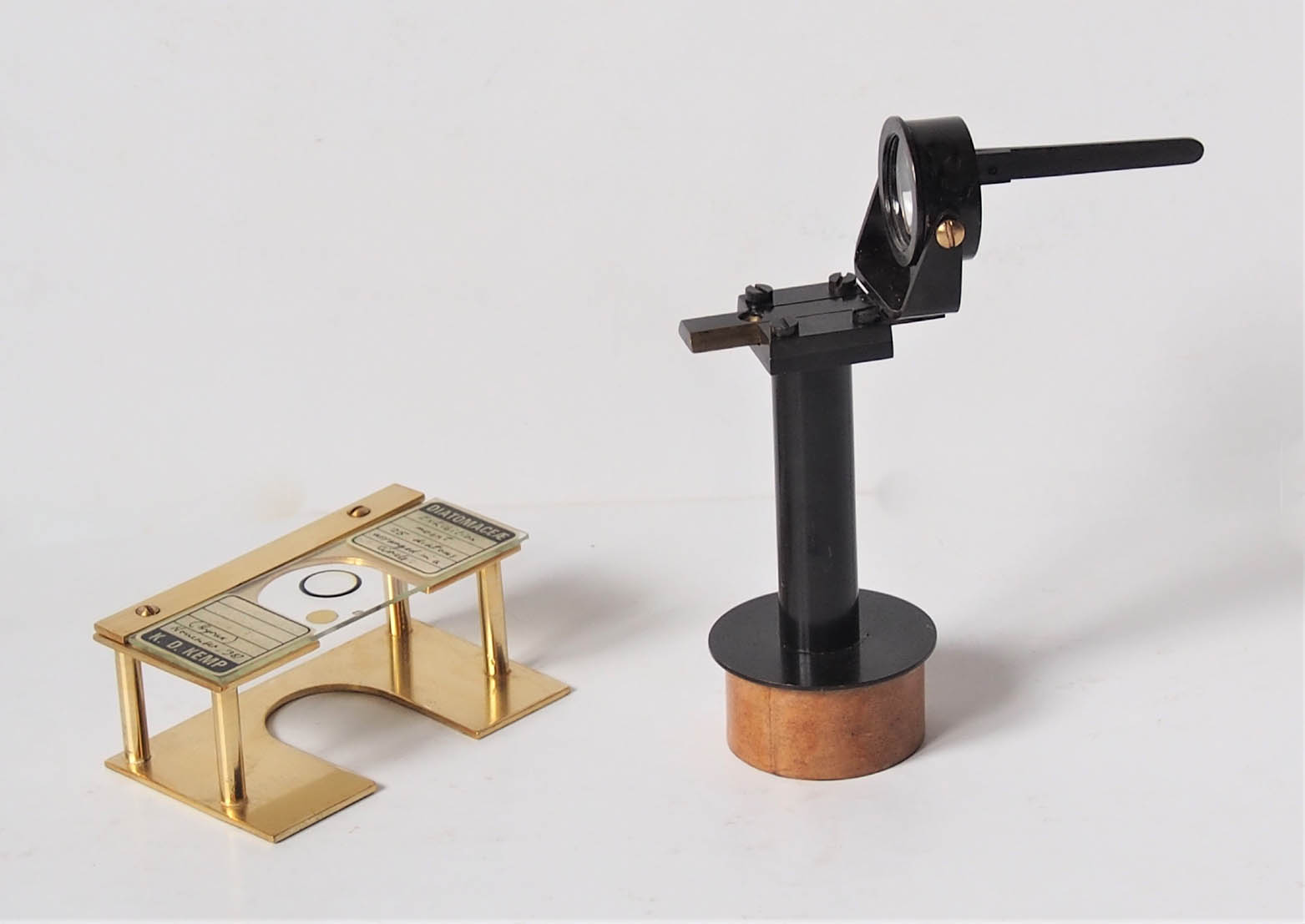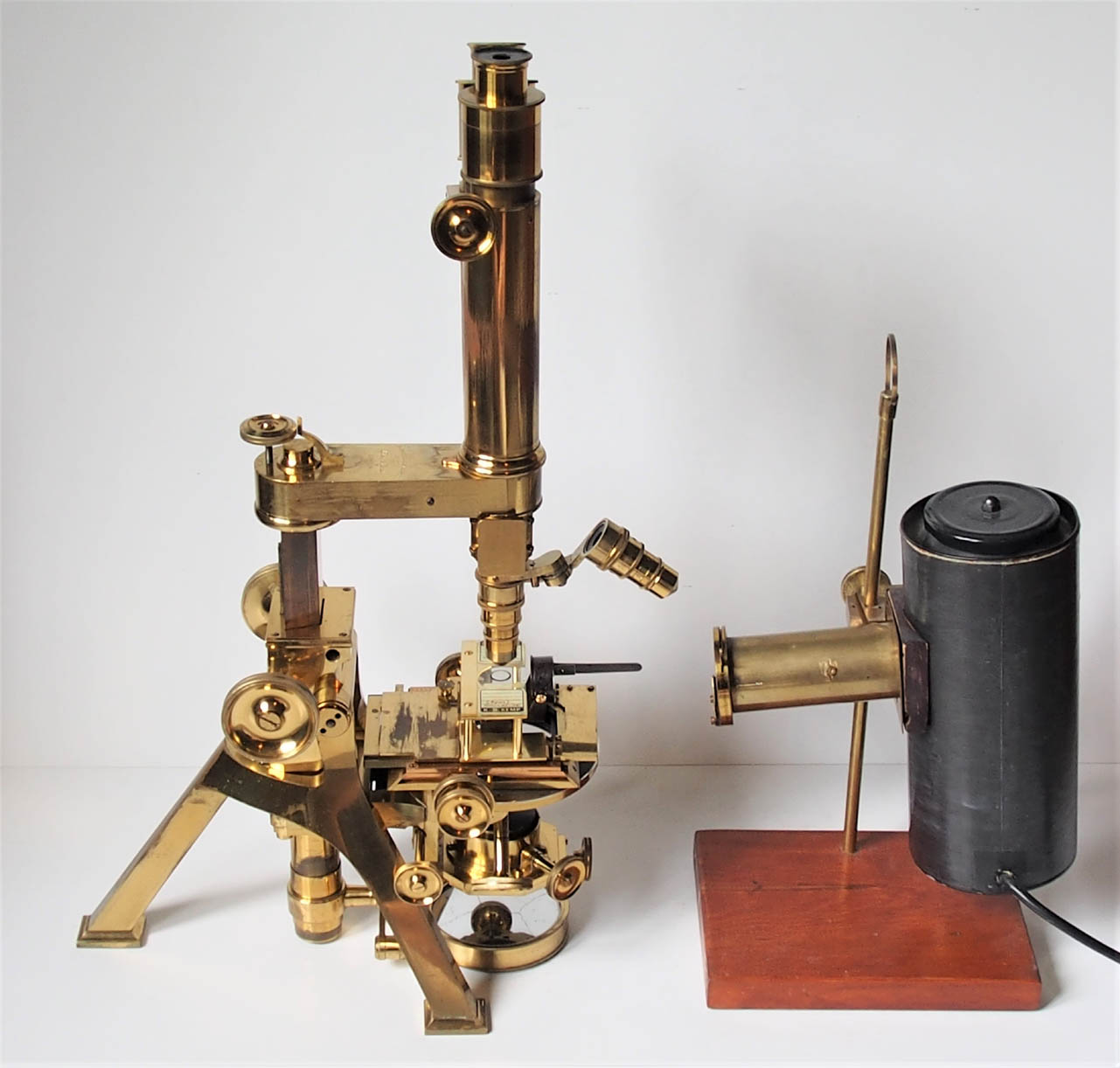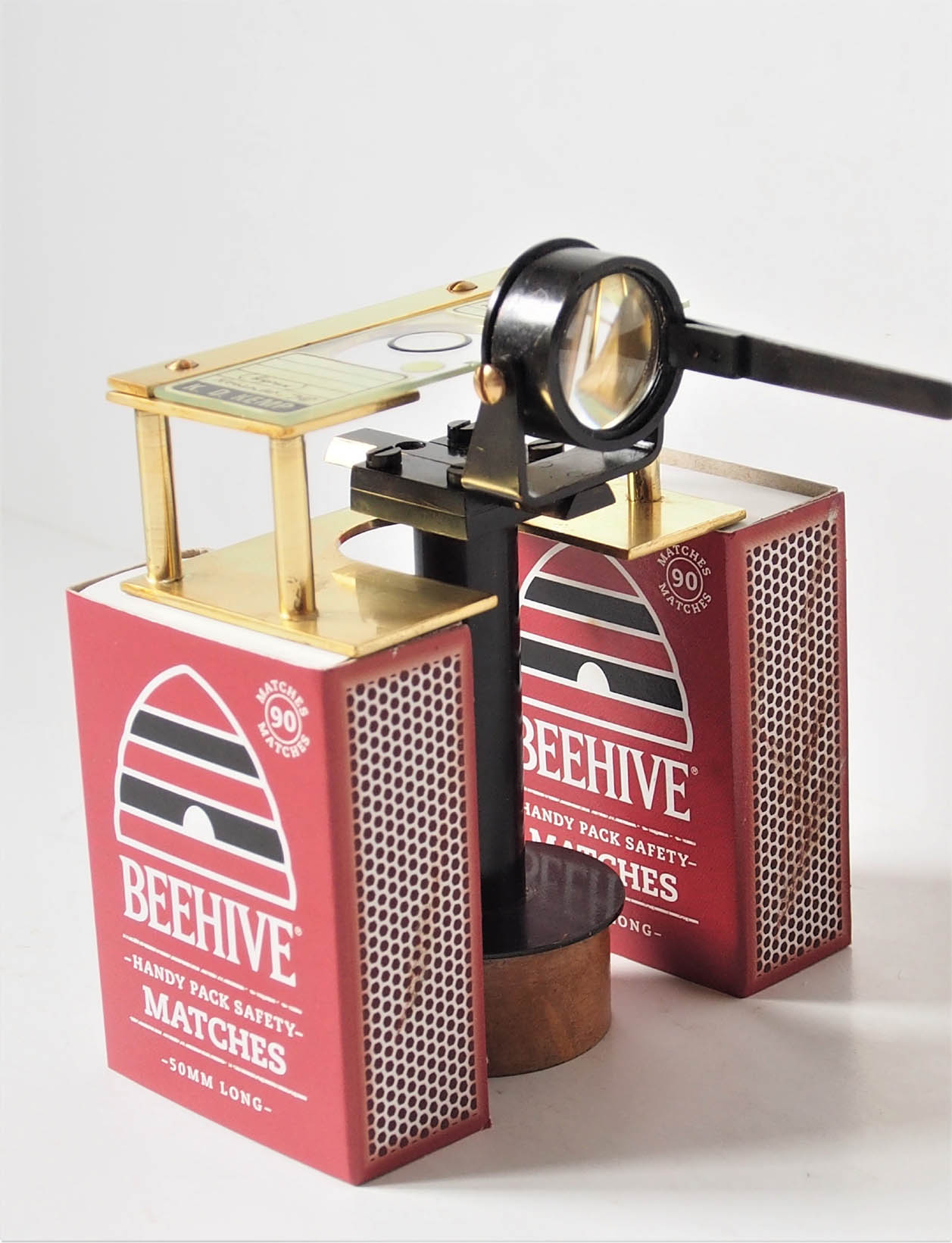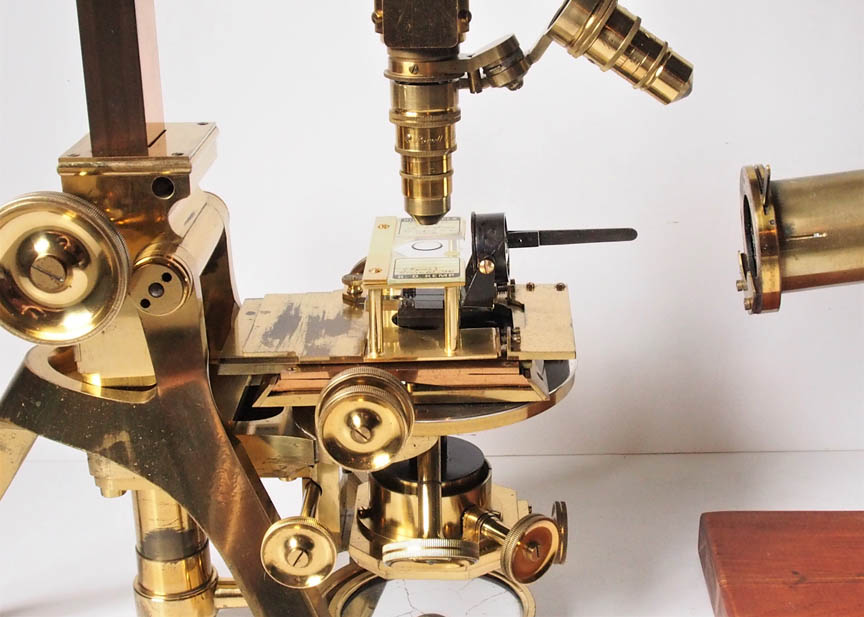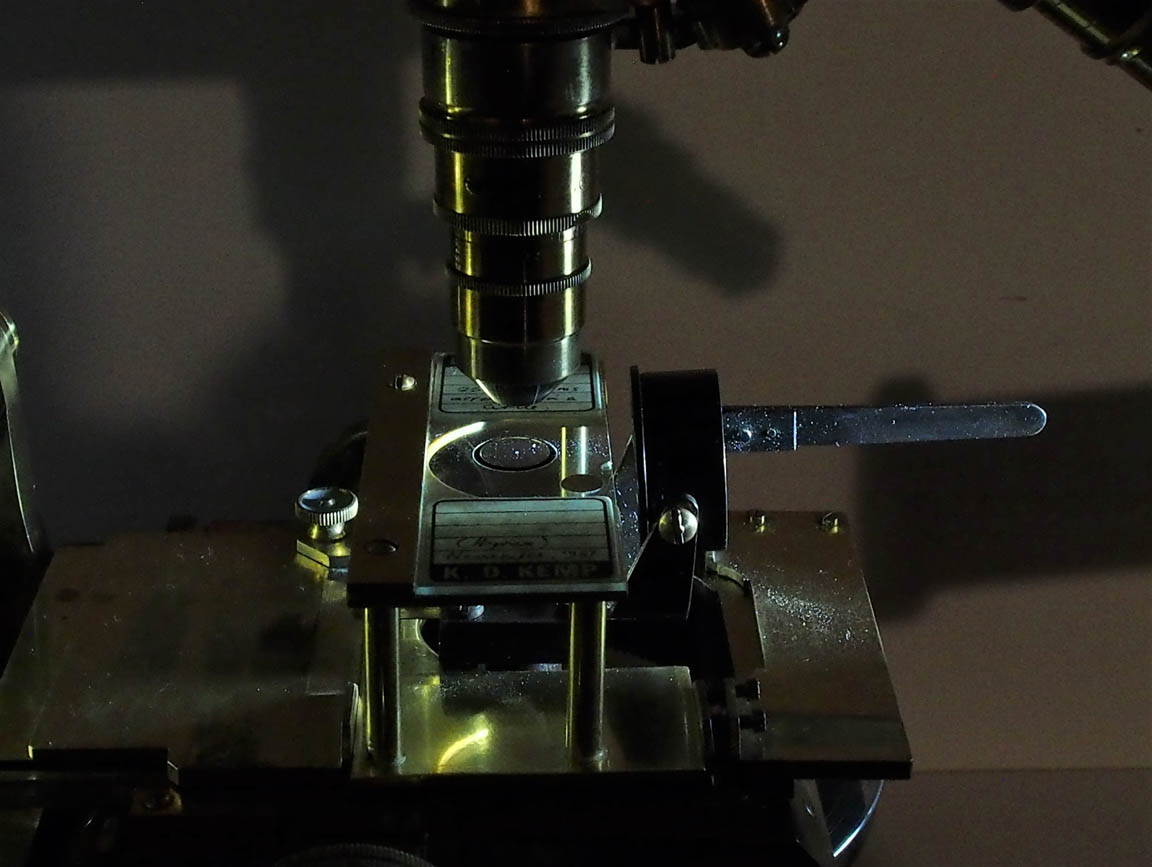DESCRIPTION:
This rare piece of apparatus consists of a 60 mm tall oxidized brass pillar, which is supported by a sleeve, which has an external diameter of 36.4 mm and fits into the rotating substage sleeve of the Powell & Lealand No 1 stand. The pillar supports a square, which carries a dovetailed slider onto which is affixed a gimbal, holding a condenser lens 20 mm in diameter, and having a focal length of approximately 3/4 of an inch. The optical component of this is made up of two plano-convex lenses placed close together. The condenser lens can be moved by means of a handle, to be angled up- or downwards, while rotation in the horizontal plane is achieved by activating the substage rotation. Likewise, the illuminator can be lowered or raised by means of the substage focus. There is a matching super-stage made of lacquered brass, consisting of a bottom and top plate, each having a U-shaped aperture, to admit the illuminator in a position close to the slide. The top plate measures 3 by 1 1/2 inch, and has a ledge, against which the slide is positioned.
HISTORY:
As has been well documented, the merits of water-immersion were initially insufficiently realized by British opticians, and whereas makers such as Hartnack had began to supply his corrected immersion lenses Nos. 9 and 10 as early as 1859, it was not until 1869 that Powell & Lealand began to fit their 1/16 inch objective with a supplementary dismountable front lens, so that the objective could be used as a dry or water immersion system as desired. It is thought, that this delay was in a large part due to the misconceptions of Francis Wenham, then considered an eminent authority on microscopy, who held the view that although immersion added brightness to the image, it did nothing to improve resolution, a notion later overtaken by Abbe's theory of diffraction. Another factor was that English opticians, such as Ross and Powell & Lealand, had brought their dry high power objectives to such a state of perfection (with Numerical apertures close to 0.99), that it took meticulous researchers, such as Lieut. Col. J.J. Woodward in Washington, and Mayall in England, using test objects such as Nobert's test plates, to show that the resolution of water immersion objectives was superior to the best dry English objectives, despite the latter's (often exessive) magnification.
So, at this point in time, we have the first water immersion objectives, but no condensers to match their numerical aperture. As has been shown, the resolution (r) depends on the formula:
r = λ
n.a.obj + n.a.cond
where λ is the wavelength of light, n.a.obj is the numerical aperture of the objective, and n.a.cond
is the numerical aperture of the condenser, provided it is not higher than that of the objective.
Objectives working in air have an n.a. with a theoretical maximum of 1.0, whereas for water and oil these are respectively 1.33 and 1.52. It follows, that while using only a dry substage condenser, the maximum resolution obtained with a water-immersion objective could not be realized. In this context, it seems almost incredible, that with their 1/16 inch water immersion objective, Messrs. Powell & Lealand managed to resolve the striations (0.2 - 0.25 micron) of Amphipleura Pellucida, one of the most difficult to resolve diatoms, in 1869. Edward Nelson, in his paper on Powell's microscopes (JRMS 1900)sheds some light on this: In April 1869, Messrs. Powell & Lealand brought out a side bull's eye, which, used in conjunction with a super-stage, gave a powerful beam of very oblique illumination. It is probable that it was with this instrument that the so-called striae
on Amphipleura Pellucida were really first resolved.
Unfortunately, Nelson gave no further description, nor did he provide an image of this illuminator. The final (1901) edition of Carpenter & Dallinger is also rather vague about it: An illuminator not so well known, or at least so much used, as its merits justified, is Powell & Lealand's small bull's-eye of 3/4 inch focus, which slides into an adapter fixed into the substage, and susceptible of its rack motion up and down. The object is placed on a super-stage, and lies considerably above, but parrallel with, the ordinary stage. The bull's eye, capable thus of being raised or lowered, and of being moved by sliding away from, or close to, the mounted object, has its plane side against the edge, and at right angles to the plane of the slip. By this means illumination of great obliquity can be obtained, and very surprising effects secured even with high powers. It was much used by the Editor and Dr. Drysdale in their earlier work on the saphrophytic organisms, and, in the days before homogenous lenses, helped us over many difficulties in detail. It was the first illuminator to actually resolve the Amphipleura Pellucida. It could be very easily obtained with a student's microscope provided with Nelson's open stage, for on this the bull's-eye could be placed against the edge of the slip without any special apparatus or fitting.
Again, no image is provided, which makes it hard to understand how it all works.
In his paper, published in the Quekett Journal of Microscopy in 1969, Andrew Booth gives the first really helpful description of this illuminator, and its use, and this also includes images. In it,the author explains how he had re-mounted a damaged Grayson ruling in realgar, and struggled making the bands (which were originally ruled on glass) visible, by using different forms of darkground illumination, by using a Powell & Lealand n.a. 1.4 chromatic oil condensor, and a Nelson Cassegrain illuminator, both with disappointing results. Mr Booth did have an original P & L bull's-eye oblique illuminator in his collection, and after making a replica super-stage, this was then found to produce extremely efficient oblique illumination at right angles to the direction of the rulings, which could then be resolved.
There is a similar illuminator in the RMS collection (fig. 119, p.125 of The Great Age of the Microscope by Turner), unfortunately misunderstood, and described as having a different purpose. Being of great rarity, items such as this come on the market only very occasionally (Flints Nov 2020), so the author, inspired by Andrew Booth's paper decided to make replicas of both the oblique illuminator and super-stage. These were created by hand out of tubular and plate brass to the correct dimensions, using images of the RMS, and Flints examples as a pattern, and re-calibrating their sizes making reference to the images in Booth's paper. The accompanying images show the end result.
In practice, this clever method of illumination works very well, but is somewhat fiddly to set up, as the cone of light arising from the small bull's-eye needs to be directed so that it travels exactly through the side of the glass carrier slip, to some 12 mm away, to illuminate the object located in the center of the slide from below, at an angle approaching 180 deg. This is also the reason, why it does not work with paper-covered slides! At lower magnifications, the brightness of an electric stand-alone microscope lamp works well, but it is suspected, that for high power work, people like J.J Woodward, and Mayall used sunlight, projected by means of a heliostat. In theory, rays which travel through glass with a refractive index of 1.52 at this angle result in a condenser with an N.A. also approaching this number. And all that, without immersion liquid, or extra thin slides and cover slips. It is therefore hard to understand, why this ingenious method of illumination has slipped into obsolescence.
BIBLIOGRAPHY:
Booth, A.D. Powell's Oblique illuminator and the examination of fine rulings. Microscopy 31, August 1969; pp. 178-181.
Bradbury, S. and Bracegirdle, B. Introduction to light Microscopy. Microscopy handbooks 42. BIOS/RMS
Carpenter and Dallinger. The Microscope and its Revelations. 8th Ed.(1901);p.333.
Frison, E. The belated construction of water-immersion objectives in Britain. Communication No. 115 from the National Museum for the History of Science, Leyden, 1960.
Nelson, E.M. The Microscopes of Powell, Ross, and Smith. I.Hugh Powell's microscopes. Transactions of the Royal Microscopical Society (1900); pp. 282- 297.
Sanchez, C. et al. Oblique Illumination in Microscopy: A Quantitative evaluation. Micron, Vol. 105, Feb. 2018; pp. 47-54.
Turner, G. L'E. The Great Age of the Microscope. The Collection of the Royal Microscopical Society through 150 years. Adam Hilger, 1989.
